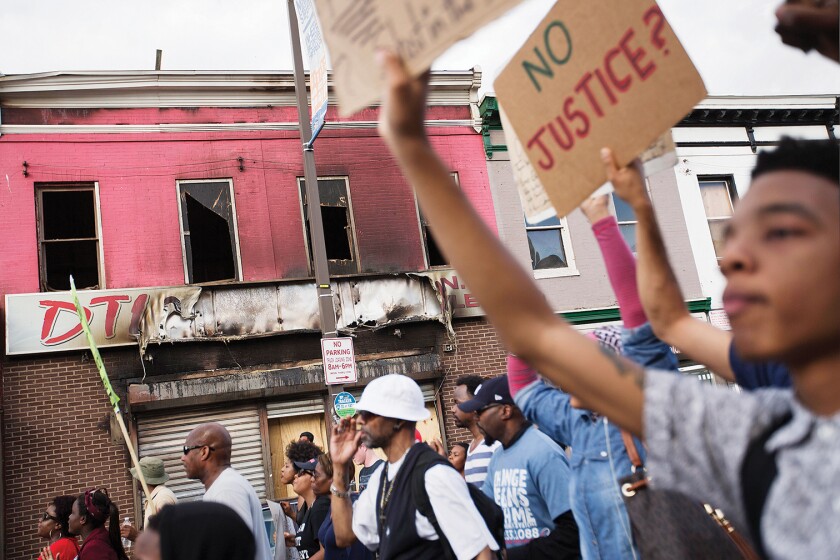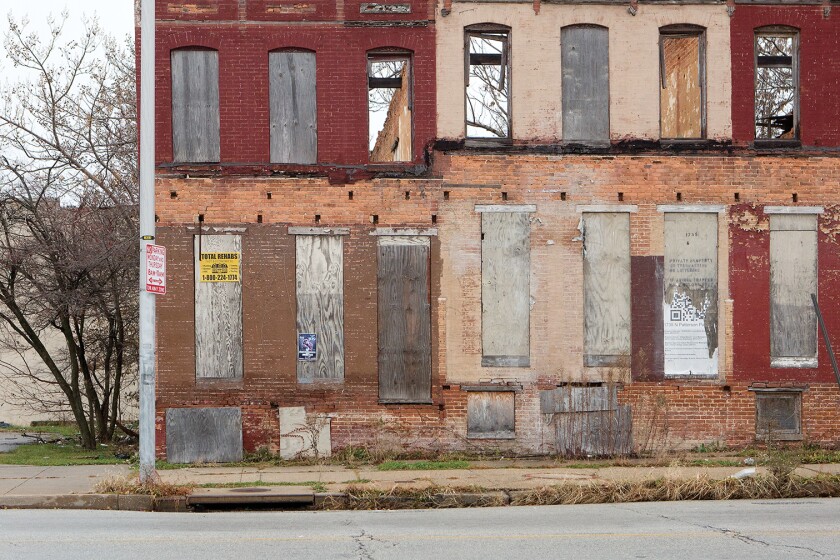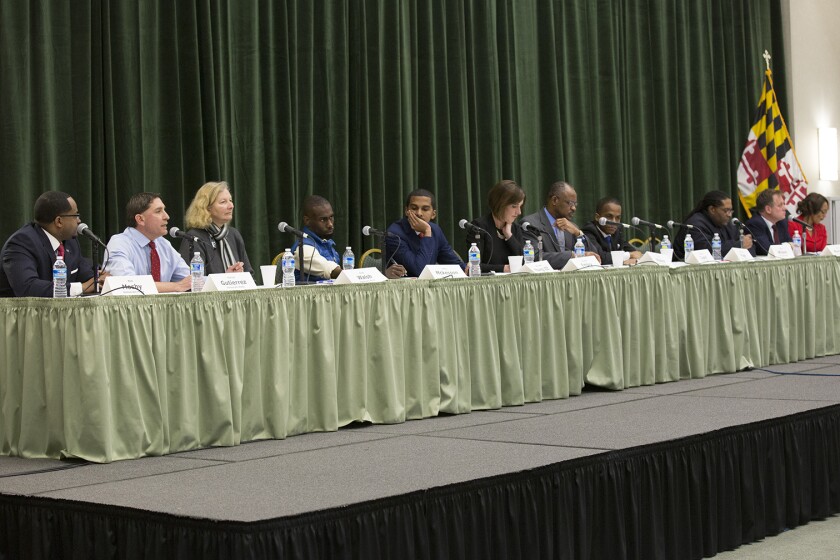The last time Dixon held that job, from 2007 to 2010, she had to give it up when a jury found her guilty of embezzling gift cards intended for poor families. Now she’s the clear frontrunner in the April 26 Democratic primary. That should be enough to return her to office. No Republican has won the mayoralty since the 1960s. The prospect of a Dixon victory has driven her critics to panic. It’s prompted the formation of an anti-Dixon super PAC and a blog that offers free campaign advice for her opponents.
“Are you willing to bet the future of your family and your city on a candidate who is a convicted criminal?” asks the blog Baltimore Rising, which argues that any of Dixon’s five main rivals is suited to be mayor -- just not her. “You put fur coats and expensive shoes above us,” an actor says to Dixon in an ad by Clean Slate Baltimore, a super PAC. “You cannot be mayor again.”
Dixon responds to all this calmly and patiently. “Of course, I’ve got to win people’s trust back,” she says. Despite some of the negative things that have happened, “we can heal.” She’s promised to raise the minimum wage, lengthen school days and reduce the crime rate.
In a January poll, nearly half of likely voters expressed support for someone other than Dixon. But a quarter of the electorate is firmly behind her, and a crowded field has divided the opposition. So while perhaps a fifth of the electorate is still undecided, the candidate who is many people’s last choice for mayor is also the odds-on favorite. “There’s a break between people who say [the embezzlement] is forgiven because she did such a good job as mayor and people who are just surprised that voters are willing to look past it,” says Mileah Kromer, a political scientist at Goucher College in Baltimore County.
The election comes at a crucial time for Baltimore. The city, already emblematic of the fight against gang violence, drug use and urban decline, now finds itself at the center of a national conversation on community policing and race relations. It’s a city at a crossroads, and the actions of the next mayor -- whoever it is -- could reverberate well beyond Baltimore.
A year ago, Dixon’s chances of winning seemed significantly smaller. That’s because it was widely assumed that the current mayor, Stephanie Rawlings-Blake, would be seeking another term. While Baltimore has long been a symbol of urban decline, there were signs under Rawlings-Blake that the city was finally turning around. After six decades of population loss, annual estimates showed more people moving into Baltimore than leaving it. Unemployment was at a seven-year low. Perhaps most important, the city that once inspired crime dramas such as The Wire and Homicide saw some of the lowest annual homicide rates in decades.
Then Freddie Gray, a 25-year-old black man from West Baltimore, died of neck injuries suffered while in police custody. Gray’s death sparked protests against police brutality, intensifying the national debate about the use of deadly force by law enforcement in poor black neighborhoods. On the day of Gray’s funeral, some protesters became violent, looting stores, pelting police with bricks, and setting fire to a senior center, a pharmacy and dozens of cars. An analyst on CNN went so far as to predict that the destruction would set back Baltimore 30 years.

David Goldman/AP
Demonstrators march past a store damaged in the riots following Freddie Gray's funeral last year. (AP/David Goldman)
Months later, as she prepared to leave office, Rawlings-Blake still seemed to resent the way the Baltimore media handled the disturbance. “The focus of the coverage,” she says, “was putting on a constant loop what was in effect a few fires. In the ’68 riots, entire neighborhoods were decimated. … Not one person was killed because of the Freddie Gray riots.”
But after the protests were over, violent crime in Baltimore began to surge. Last year police recorded 344 homicides, the highest number since 1993 -- when the city had 100,000 more residents. While the number of homicides rose in many large cities, Baltimore’s increase was on a much greater scale. And it wasn’t just murder: Robberies, burglaries and automobile thefts all saw percentage increases in the double digits.
The spell of bad news hurt Rawlings-Blake politically and in remarkably short order. Earlier in 2015, she was being mentioned as a top prospect to fill a U.S. Senate seat. By September, she had announced that she would be leaving office. After her decision, polling by the University of Baltimore and The Baltimore Sun revealed that if she had stayed in the race, 7 in 10 likely voters would have chosen someone else. The opposition stemmed in part from her handling of the riots, but voters also had larger concerns about underlying issues that they saw leading to the unrest, such as joblessness and systemic racism. About 55 percent of those polled said they thought things in Baltimore were headed in the wrong direction.
As an immediate matter, the next mayor will be called on to address community concerns about policing. There’s no question that will happen. Several of the leading candidates, including Dixon, have called for police to wear body cameras, stronger civilian oversight of law enforcement and an expansion of foot patrols to improve officers’ relationship with residents.
But the focus of the candidates’ platforms goes well beyond public safety. State Sen. Catherine Pugh, who ranks second in the polls, talks about adult literacy and universal pre-kindergarten. Nick Mosby, a first-term councilman running for mayor, wants to cut property taxes and redevelop vacant properties. Carl Stokes, another councilman in the candidate field, promises to institute regular audits of every city agency. And DeRay Mckesson, a Black Lives Matter activist, would hire more lead paint inspectors and institute a fund to help tenants fight in court the threat of eviction.

Only a year ago it was assumed that the current mayor, Stephanie Rawlings-Blake, would be seeking another term.
It is a reminder of just how many problems the next mayor will have to contend with. Persistent homelessness, child poverty, urban blight, joblessness among ex-offenders and a discredited public school system are only a partial list. When a recent poll asked likely voters to identify the No. 1 underlying issue in Baltimore, the top answer was a lack of job opportunities. Respondents had the option to pick “lack of law enforcement,” but most of them didn’t. Voters believe “that’s not the root cause,” says Steve Raabe, who ran the poll. “There are much more fundamental issues at play in these neighborhoods. The problems are very difficult and complicated.”
Gray’s death shed light on racial and economic inequality in Baltimore, a condition that former Mayor Kurt Schmoke, echoing the rhetoric of Mayor Bill de Blasio in New York, refers to as a “tale of two cities.” In the past decade, a half dozen Baltimore neighborhoods have flourished with new coffee shops, bars, restaurants and gyms, along with an influx of well-off residents, mostly white, who enjoy those amenities. This is the city of Johns Hopkins University, the T. Rowe Price brokerage house and Under Armour athletic apparel. But beyond these bright spots are neighborhoods such as West Baltimore, where Gray lived. They continue to see high rates of crime, poverty and vacant housing. While the city’s overall population has been growing, many of these neighborhoods have seen no increase at all. Gray’s death amplified the feeling that the city’s revival has left most of the residents behind. “Certain parts of the city were moving rapidly in the right direction,” says Councilman Mosby, “but it created a chasm.”

What to do about blighted neighborhoods is just one of many problems facing the next mayor.
To deal with the chasm, the next mayor needs to address the concerns of Freddie Gray’s Baltimore. This, as much as anything else, explains why Dixon is likely to win. The 62-year-old Dixon grew up in West Baltimore and taught in Head Start, the early childhood education program for low-income families. Her election to the city council in the 1980s was part of a power shift from white elected officials to a new generation of black leaders.
“People who are from West Baltimore, from the areas that haven’t been touched by gentrification, she’s their voice,” says Kromer, the political scientist. “She’s one of them.” This was evident at Gray’s funeral, where both Rawlings-Blake and Dixon attended, but only Dixon received a standing ovation.
Dixon’s opponents have tried to attract voters with white papers and detailed policy proposals, but her appeal is more intimate. Voters interviewed by The Baltimore Sun last summer said they supported Dixon because they knew her personally -- she had helped them out over the years, connecting them with food stamps or finding them a job in the city. JaqueLine Joi, a resident of the Canton neighborhood, says Dixon won her support when the then-council president showed up on a rainy morning at a community event Joi was hosting. Dixon hadn’t even been expected to come.
Dixon doesn’t have the problem of introducing herself to voters. They already know her. They know what a Dixon administration would look like. Much of her campaign has been about re-establishing trust with voters. “I’m asking the citizens to forgive me,” she said in an interview with the local podcast On Background. “I made a bad choice, a couple bad choices. That’s not who I am.”

Having won three citywide elections, Dixon has better name recognition than anyone else.
While most of the other candidates pitch themselves as outsiders who can fix Baltimore, she has cast herself as a symbol of the wounded city. Her comeback, she says, would be Baltimore’s comeback too.
To Dixon supporters, she’s already served her time. As part of her probation, she gave $45,000 to charity and completed more than 500 hours of community service. Her record has been expunged. In another city, at another time, her ignominious departure would have ended her political career. But in Baltimore, where all too many have faced their own probation sentences, or know someone who has, enough voters seem willing to forgive Dixon. “There are erasers on pencils for a reason,” Joi says. “Sometimes you have to look past [the mistakes] and move on.”
Her detractors argue the gift cards were indicative of other ethically dubious behavior. When she became council president, she dragged her feet on giving up a job that a state board ruled to be a conflict of interest. Later she pressured Comcast to award work to a company that employed her sister. While she was convicted only of stealing gift cards, she had to take a plea deal to avoid going to trial again on perjury charges.
Still, many voters feel some nostalgia for the Dixon years, which included an 11 percent decline in violent crime and a drop from 282 annual homicides to 238. Her administration implemented a popular free downtown bus service and an easy-to-use recycling program. She also ended zero-tolerance policing, an anti-crime strategy now credited with the mass arrest and incarceration of black men for nonviolent offenses.
If Dixon wins, her detractors will dismiss it as the freak result of a well-known candidate running in a crowded field in a low-turnout election. The anti-Dixon blog, Baltimore Rising, has gone so far as to beg some of Dixon’s low-polling rivals to drop out so one person can mount a proper challenge. “Their continued presence in the race,” the blog argues, allows “a small minority of fervent voters to elect the least desirable major candidate.”

Dixon joined 11 other mayoral candidates in a debate in March.
There is some political logic to this argument. Dixon is one of 16 candidates in the Democratic primary. Her rivals include a state senator, two sitting councilmen, a criminal prosecutor, a businessman and a civil rights activist. Because the top five candidates are all well funded -- some have raised more money than Dixon -- no one has a financial incentive to drop out of the race.
Having won three citywide elections (two as council president and one as mayor), Dixon has better name recognition than anyone else. She polls poorly among white voters, but only about a third of Baltimore’s electorate is white, and support from that voting bloc is evenly spread among four candidates. In the two most important demographic groups, African-Americans and women, Dixon led by wide margins in polls earlier this year.
If the polls prove accurate, Dixon would win with a plurality of the vote -- not exactly a mandate. But she would treat it as a form of vindication. “Here’s the thing about Baltimore,” she says in a campaign video. “When you get knocked down, someone is there to help you back up. This is the city of second chances.”









